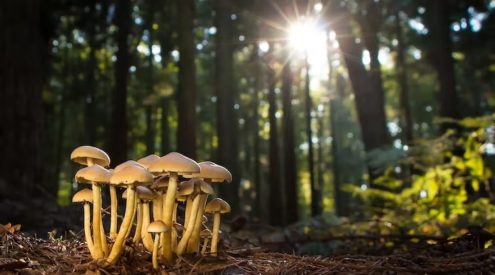Until very recently humans were thought to be islands of biological efficiency, gathering oxygen, processing food and getting on with the business of living. Our cells attacked germs and kept us safe from dangerous pathogens.
However, in the past few years researchers have discovered that we’re a social network. In fact, most of what we are isn’t human at all, but a wacky ecosystem of bacteria that outnumber our cells 10 to one. And much of it is truly wild.
For a start, about 20 per cent of the genetic information in your nose and half the residents in your stomach are unknown to science. It’s related to stuff being dubbed biological dark matter. The truth is you’re only one per cent human and 99 per cent bacterial.
In other words, out in the tropical jungles or questionable back streets of travel, most of the lurking bacteria are your close relatives.
If you want to retain a strong sense of identity read no further.
The reason all this wasn’t discovered years ago was because people in white coats staring into microscopes were generally looking for harmful bugs and ignored all the other stuff on their slides. The idea of benign microbes never crossed their minds. But increasingly accurate and ultra-fast genesequencing equipment has changed all that.
‘Just because microbes are foreign and we acquire them throughout our life,’ writes Jennifer Ackerman in Scientific American, ‘doesn’t mean they’re any less a fundamental part of us.’ By sequencing the genes in this microbial soup, scientists are creating a catalogue of just who we are and of the non-us bacteria called commensals.
Let me introduce you to most of what you are. Bacteria are the oldest living organisms on Earth; they’ve been around for billions of years. They’re single-celled microscopic organisms with one tiny DNA strand and reproduce by dividing. Right now there are about 10 trillion in or on you as you read this (don’t scratch).
Babies are born bacteria free and pick up their first useful batch in the birth canal. After that the commensals come thick and fast – through mom’s first kiss, the sheets of the cot, breast milk and all the cooing relatives and friends. After that, their bacteria multiply fast.
We couldn’t survive for long without them. They create the enzymes necessary to make vitamin B12, convert carbohydrates in things such as potatoes, apples, oranges and wheat into usable glucose, regulate the flow of stomach acid, regulate our appetite, influence stem cells in the manufacture of fat, muscle and bone and many other things still under research.
The puzzle is why our immune system lets all this happen. You’d think it would distinguish between the body’s own cells (self) and non-self and boot out the interlopers. Why this doesn’t happen is still a mystery.
Research going on at Caltech in California suggests that bacteria actually strengthen our immune system and fight infection. Some evidently prevent our bodies from mistaking self for non-self and attacking, causing auto-immune disorders such as Crohn’s disease. A problem, says Ackerman, is that things such as antibiotics, useful as they are, are taking out the good with the bad.
And one of the good bugs is Helicobacter pylori, which tells us to stop eating when we’re full, the absence of which could explain rising obesity levels. If you think all this is odd, it gets odder.
Molecular biologist Bonnie Brassler, who teaches at Princeton University in the USA, has discovered that bacteria ‘talk’ to one another on a micro equivalent of Facebook. If your sushi suddenly starts to glow in the dark, she has the answer.
Being such simple organisms, she wanted to know how they could do anything at all. They seemed too small to have an impact on their environment unless they acted in synchrony. Could they be communicating?
The bacteria that create marine bioluminescence seemed a good place to start. They create light – instantly and all together – only when they reach a certain density. But how do they know the right moment? What Brassler found is that they talk with a chemical language, constantly sending out molecular signals. When the molecules reach a certain density – wham! – they light up.
Certain shallow-water squid, she found, have pockets of these bacteria beneath them which turn on at night to prevent a moon shadow, which would alert predators to their presence. They turn off the light in daytime by ejecting most of the rapidly multiplying bacteria, which then switch off. They’re the stealth bombers of the ocean. The switch mechanism is called quorum sensing.
This is a force for good and bad. Because the bad bacteria are so small and you’re so big, they couldn’t make you ill acting independently so they multiply under the radar of your defence system. Then, in a private language, they send out the command to attack.
But, to be effective, they need to know what other bacteria are around.
Brassler’s team went back to their microscopes and found that bacteria also have a multilingual, inter-species language, a sort of chemical Esperanto. They know who’s around them and they can count. This way they make things happen, like us for instance.
‘Bacteria have been around for billions of years and humans for only a few hundred thousand,’ she says. ‘We think they made the rules for multi-cellular organisation. They can say “me” and can say “you”. That’s how our bodies work; how a heart doesn’t become a lung or skin a brain.’
In a way, it’s bacteria which invented most of what we are. Humans just added a few bells and whistles to become Homo sapiens.
The future of medicine, of course, would be to create language that inhibits the communication of bad bacteria and improves chatter among the good ones. Right now that’s what’s being done. The future of healthcare is about to take a quantum leap.

















